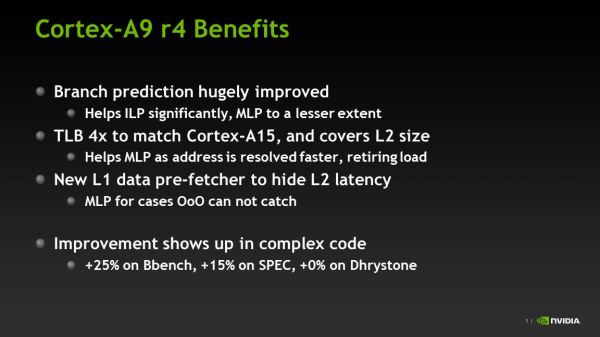NVIDIA Tegra 4 Architecture Deep Dive, Plus Tegra 4i, Icera i500 & Phoenix Hands On
by Anand Lal Shimpi & Brian Klug on February 24, 2013 3:00 PM ESTThe Cortex A9 r4p1
Although we just call ARM’s previous architecture by its Cortex A9 name, there have been multiple revisions to the A9 architecture since its introduction. Tegra 2 implemented Cortex A9 r1p1, while Tegra 3 used r2p9. With Tegra 4i, NVIDIA moved to the absolute latest version of the Cortex A9 core: r4p1.
There are some significant changes to the Cortex A9 in r4p1. The GHB, L2 TLB and BTAC all grew by 4x and are now sized equally between the A9 and A15 implementations (16K predictors, 512 entries and 4096 entries, respectively). These changes help improve branch prediction accuracy, which further increases IPC on an already very efficient design.
The A9 r4p1 also has an enhanced data prefetching engine, including a small L1 prefetcher and dedicated hardware for the cache preload instruction.
NVIDIA claims a 15% increase in SPECint_base for the Cortex A9 r4p1 vs. r2p9, which is pretty impressive. Combined with the 2.3GHz max frequency, Tegra 4i’s CPU performance should be a healthy improvement over what we have in Tegra 3 today.
Tegra 4 Clock Speeds
Each of the four primary Cortex A15s is driven off the same voltage and frequency plane, although each core can be power gated individually. This is similar to how Intel designs its processors, but at odds with Qualcomm’s independent voltage/frequency planes.
NVIDIA does a good job of binning its SoCs, and the same will continue with Tegra 4. All four cores are capable of running at up to 1.9GHz, although NVIDIA claims we may see configurations with even higher single core boost frequencies (or even lower max frequencies, similar to Tegra 3). As I already mentioned, the fifth Cortex A15 runs at somewhere between 700 and 800MHz.
The Tegra 4 GPU operates at up to 672MHz, up from the 520MHz max in Tegra 3.











75 Comments
View All Comments
tipoo - Sunday, February 24, 2013 - link
Under 500 in Sunspider, about twice as fast as anything else ARM. But then again, it's a few months newer than that, and actually still not shipping. And as usual with Nvidia they're early to each party (first to dual core, first to quad core), but not always the best performing. We'll see if other Cortex A15 designs beat it.I'd love to see four of those cores paired with SGXs upcoming 600/Rogue series.
jeffkibuule - Sunday, February 24, 2013 - link
SunSpider is so software sensitive that a Tegra 3 @ 1.2 Ghz on Windows RT beats a Snapdraon S4 Pro @ 1.5Ghz on Nexus 4 using Chrome. It's a terrible benchmark because its so dependent on underlying kernel optimizations in the Android phone market.tipoo - Sunday, February 24, 2013 - link
True, other benchmarks are similarly impressive though.karasaj - Sunday, February 24, 2013 - link
Psh it has nothing on my desktop! 125ms on sunspider... Nvidia so behind.Anyways, still looks impressive. I really want to see some Krait 600/800 benchmarks.
tipoo - Sunday, February 24, 2013 - link
The fact that they're getting well below an order of magnitude slower than desktops is impressive in itself too. Even with iPad 2 level performance I still was reluctant to do most of my web browsing on a tablet for the performance. Maybe with Tegra 4 and beyond hardware speed that will change.Mumrik - Sunday, February 24, 2013 - link
As someone with heavily tabbed browsing habits, I don't think I'll ever make that jump (and I own a tablet).tipoo - Sunday, February 24, 2013 - link
Also true, that's my other thing. I like to open a bunch of background tabs and have them ready as I go through each one. Right now, tablets don't do background loading, as far as I know, and if they did they wouldn't be powerful enough to keep the main tab smooth while doing it.Tarwin - Monday, February 25, 2013 - link
Tablets DO do background loading, as long as they're android. The only performance I've seen is from lack of RAM on my phone and lack of bandwidth on the phone and tablet but those things affect any computer as well. One observation to ne made, they do load in the background but things like audio and video playback will pause if you switch to another tab.von Krupp - Monday, February 25, 2013 - link
Even Windows Phone 7.5 and 8 do background loading. I haven't used it, but I'd wager that RT does as well, if even the gimpy mobile OS can.tuxRoller - Sunday, February 24, 2013 - link
As someone who had, until recently, over 40 tabs open on my chrome browser (Nexus 4), the critical problem has been memory. With enough memory, and good enough task management, these problems tend to go away.Of course, maybe you are than 0.00001% who has hundreds or thousands of tabs open in which case I pity any computer you are likely to own.